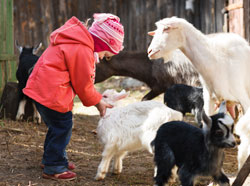Animal Exhibits
Stay Healthy at Animal Exhibits
There are many ways to explore the animal world. Follow these tips to help prevent illness when visiting animal exhibits like petting zoos.
From watching calf roping at the rodeo to petting goats at the county fair, there are many ways to explore the animal world. Exhibits such as petting zoos and fairs allow children to experience coming face-to-face with animals. This interaction allows people to learn  more about animals and helps to build important human-animal bonds.
more about animals and helps to build important human-animal bonds.
Unfortunately, many people become sick every year because of a visit to an animal exhibit. It's important to remember that animals sometimes carry germs that are harmful to people. If you forget to wash your hands after petting an animal, or bring food or drinks into an area where animals are exhibited, you increase your chance of getting sick. You can learn more about these germs and how they cause illness by visiting CDC's Healthy Pets Healthy People.
Below are some tips to help you stay healthy when visiting animal exhibits.
Animals and Health
Check out two CDC websites with helpful resources.
- Gastrointestinal (Enteric) Diseases from Animals: Information about zoonotic outbreaks, prevention messages, and helpful resources.
- Healthy Pets Healthy People: Information on health benefits of pets and disease risks.
Wash your hands often if you visit an animal exhibit. Remember to wash your hands right after petting animals and when you leave animal areas.

Supervise children around animals.
Wash Your Hands Often If You Visit an Animal Exhibit!
- Find out where handwashing stations are located.
- Always wash your hands right after petting animals or touching anything where the animal is housed.
- Wash your hands when you leave animal areas, even if you did not touch the animals.
- Running water and soap are best. Use hand sanitizer if running water and soap are not available. Wash your hands with soap and water as soon as a sink is available.
- See directions for washing hands.

Eat and Drink Safely
- Keep food and drinks out of animal areas, like their habitats and feeding areas.
- Food should not be prepared, served, or eaten in areas where animals live and feed (with the exception of service animals).
- Don't eat or drink raw (unpasteurized) products made or sold at animal exhibits, including milk, cheeses, and cider or juices.
- Don't share your food with animals, to avoid picking up any germs from the animals and to make sure animals eat the right foods. Animals should eat the food made for them.
- Remember: Wash your hands before preparing food or drinks and before eating and drinking.
Keep Children Safe Around Animals
- Children younger than 5 years always need adult supervision in animal areas.
- Never allow children to put their thumbs, fingers, or objects (for example: pacifiers) in their mouth when they're around animals or in an animal area, such as an empty livestock barn.
- Encourage and supervise handwashing.
- Do not take or use strollers, bottles, pacifiers, spill-proof cups, or toys into animal areas.
- Children younger than 5 years, people older than 65, and people with weakened immune systems should take special care around animal exhibits. You can find out more about these precautions on CDC's Healthy Pets Healthy People site.
If You Manage or Design an Animal Exhibit
- Design the exhibit to separate animal areas from places where people eat.
- Use signs to point out the areas where people can eat, and the areas for animals.
- Install handwashing stations at exits of animal exhibits. Make sure that some of the handwashing stations are low enough for children to reach.
- Use plain language and pictures to show visitors how to stay safe and healthy when visiting animal exhibits.
Education/Information
- Encourage visitors to wash their hands after visiting or handling animals.
- Be aware that healthy animals can carry germs that might make visitors sick.
- Train staff and educate visitors about preventing disease transmission between humans and animals.
- Use a variety of methods to provide information to the public. For example, use brochures, signs, and verbal instructions. See a sample visitor handout.
Posters and Podcasts
More Information
- CDC′s Gastrointestinal (Enteric) Diseases from Animals
- Educational posters and other resources (available in multiple languages):
- Visit CDC′s Healthy Pets Healthy People site for more information on how you and your pet can stay healthy.
- Read the Compendium of Measures to Prevent Disease Associated with Animals in Public Settings


